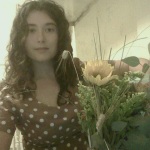Musings from Students of the Pardes Institute of Jewish Studies in Jerusalem
Posted on September 9, 2014 by Sarah Marx
 For a place so much associated with desert and stone and sun, Jerusalem is full of blue. My morning walk to school is painted blue, in both broad and slender strokes: the giant turquoise sky, or the thin stripes of the Israeli flag, or the joyful cerulean paint on someone’s shutters or garden fence. Even the other colors – gold, green, pink – seem alight with undertones of bright blue. It’s a color that stands out here, maybe more than any other. Sometimes it reminds me of water and wind, both of which feel scarce and precious here; sometimes I see it and think of tchelet, the rare dye that winds through tzitzit and across the edges of tallitot.
For a place so much associated with desert and stone and sun, Jerusalem is full of blue. My morning walk to school is painted blue, in both broad and slender strokes: the giant turquoise sky, or the thin stripes of the Israeli flag, or the joyful cerulean paint on someone’s shutters or garden fence. Even the other colors – gold, green, pink – seem alight with undertones of bright blue. It’s a color that stands out here, maybe more than any other. Sometimes it reminds me of water and wind, both of which feel scarce and precious here; sometimes I see it and think of tchelet, the rare dye that winds through tzitzit and across the edges of tallitot.
That’s never more apparent than during Shacharit, when we face the east-facing windows and a giant blue horizon stretches out like the new day. Two mornings ago, I found myself staring, wondering, at that sky as I davened; in the corner of my eye, the whiteboard markers and the edges of prayer shawls and the covers of Koren siddurim were all blue. For a little while I was afraid to notice – after all, wasn’t that a sign that my attention was wandering? Shouldn’t my eyes be locked on the page in front of me, or at least on the velvet curtain with a Sefer Torah lurking behind it? But I couldn’t stop noticing sensory things: the blue, and the elementary-school bell that blares the tune of a psalm every few minutes, and the moments in which the many voices in our little minyan swirled into harmony. I didn’t know if it was right, but it wasn’t a distraction – that minyan, that early morning in a cramped classroom on a third story in an industrial enclave in Jerusalem, was unlike any davening I’ve ever done.
Afterwards I asked myself: why? What was there that I’ve never had? What has consistently been present in the minyanim that provide both the beginning and the centerpiece of a day at Pardes? For a long time, I’ve associated great prayer with wilderness and solitude; what’s going on here that makes communal prayer so vivid? Is it something in the water?
I don’t have an answer for that. Actually, I have a lot of potential answers – a committed leadership, an open and loving space, a group of bright and passionate and lively people who are all seeking something, the city of Jerusalem itself. And here’s another potential answer: details. Pardes is really great at details, like the details of Gemara, or the details you notice when your eyes are wandering around the room. This first week and a half has taught me how important, how laden with meaning, the details can be. There’s a tendency – well, at least I have a tendency – to talk about religion or religious concepts in vague platitudes, and use language to skip over the concrete. Pardes doesn’t allow that. In chevruta, we translate every single word, and the nuances of those words are as sacred as their broader philosophical implications. In chevruta, we also talk about one another’s days, and the very real experiences we’ve had that give weight to the claims we make in conversation. Like our sages, we talk about fruit trees and the precise locations of sacrificial portions; we share meals and argue about minutiae and fall in love with particular characters in particular moments of Chumash or Talmud. And when we say the words of prayer – words that so often describe specific instants or relationships or sensory attributes – we celebrate not only the broad ideas but the details of the world around us. We praise the created world, and we celebrate it in the intricate bonds of community and the elaborate choreography of ritual.
So when I hear the “Tov Lehodot Lashem” school bell ringing through the windows, or when I notice the gradient of blue all around our Shacharit minyan, I’m not distracted. Instead, I’m reminded of the world around me, so rich in a thousand different ways, and I’m unspeakably thankful for the coming day. It turns out prayer isn’t only possible alone in the wilderness. Having people there with you, and the thousand little things they’ve observed and described and created, and the things they will continue to create, is pretty good, too.